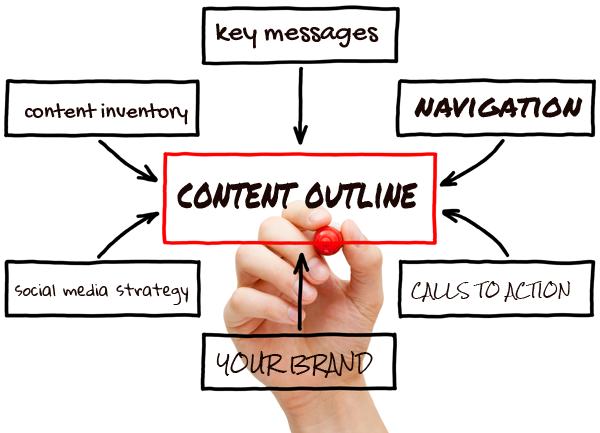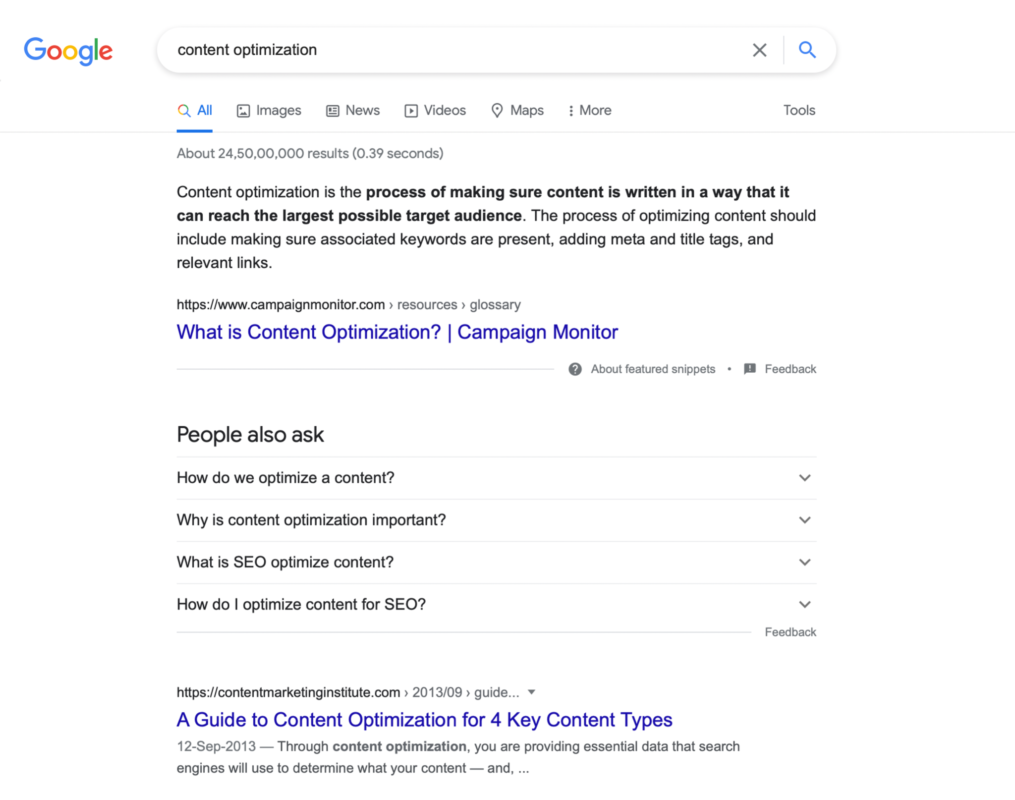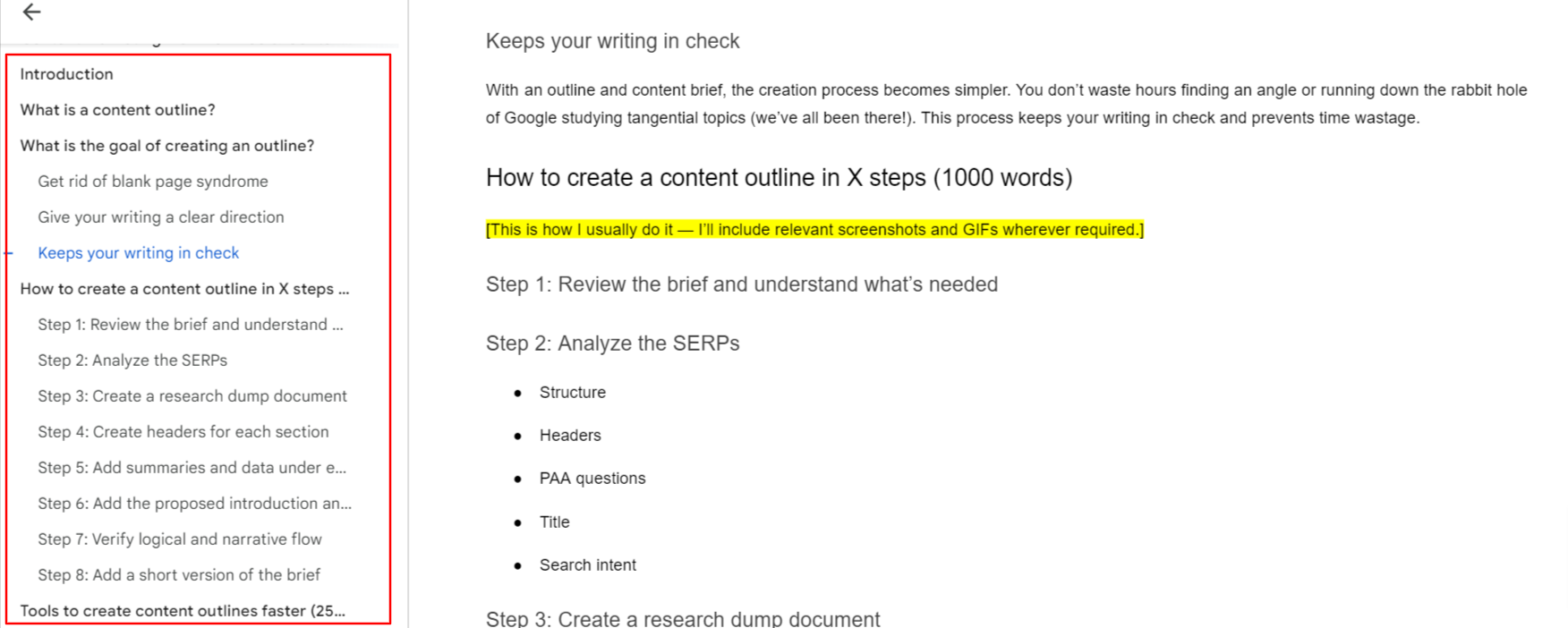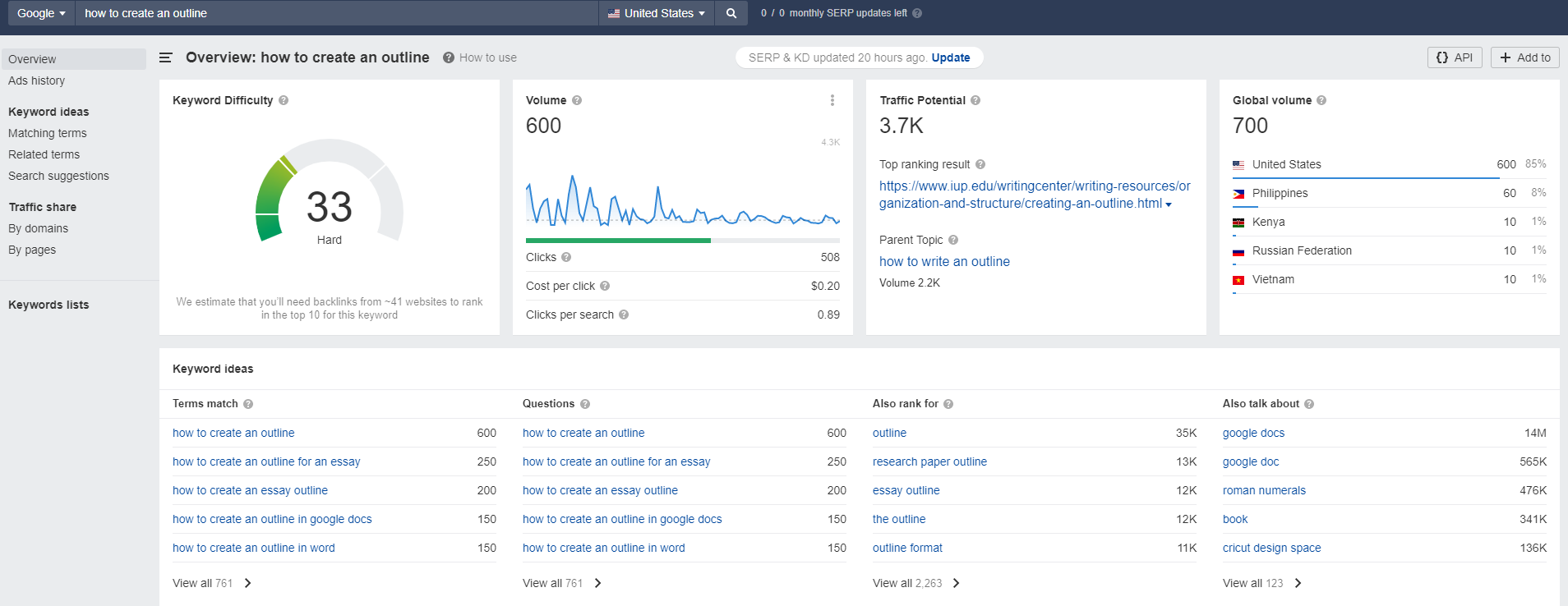Crafting a content outline is a crucial step in the content creation process. It acts as a roadmap, guiding writers to create quality content that is well-organized, focused, and engaging.
In this step-by-step guide, we will explore what a content outline is, why it is important for SEO, how to create a content outline, the components of an effective outline, tools to create a solid content outline faster, content outline examples, and frequently asked questions about content outlining.
By the end of this guide, you will have a clear understanding of how to craft a content outline that will enhance your writing process and improve the overall quality of your content.
What is a Content Outline?

A content outline is like a roadmap for creating written content, such as articles or blog posts. It helps writers organize their ideas by outlining the main topics, subtopics, and key points to cover in the piece.
This document typically includes the primary keyword or topic, details about the intended audience and tone, word count goals, suggested headings, and any references or data to include.
By using a content outline, writers can structure their content effectively, avoid writer’s block, and ensure they cover all necessary information for their readers.
Why is Content Outlining Important for SEO?

Content outlining plays a crucial role in SEO because it ensures that your content meets the criteria set by search engines for high-ranking material.
By creating a structured outline before writing, you can ensure that important elements such as keywords, audience targeting, tone, and formatting are incorporated effectively.
This helps you create SEO content that not only appeals to readers but also satisfies search engine algorithms, increasing the likelihood of your content being discovered and ranked higher in search results.
In essence, a content outline serves as a roadmap for crafting SEO-friendly content that resonates with both search engines and your audience.
How to Create a Content Outline (the Easy Way)
Step #1: Analyze Search Intent, Find your Keywords

Do keyword research to find high search volume keywords related to your topic. This helps target user intent and rank better in search. Choose 5-10 primary keywords.
Step #2: Identify your Angle

Determine a unique angle, perspective or viewpoint to approach the topic. This creates an interesting and differentiated article.
Choosing the right angle is important because it guides what you’ll write about. Plus, it helps you beat your competition.
Your working title acts as your angle. Without it, your blog post might wander aimlessly.
A good blog post title is:
- Clear
- Practical
- Interesting
Step #3: Create Headings for Your Article

Now, let’s make our outline look like one. We’re going to come up with titles for different parts of our article.
The main title of your article will be based on the angle we picked earlier. For example, mine is “What is Content Optimization? How to Optimize Content.”
Then, we’ll write the introduction, but we’ll do that later.
After that, we’ll create subheadings called H2s. From the research we did earlier, you probably already have some ideas for these. Put them in order.
You can also include H3s and H4s under your H2s to add more detail to your outline.
If you don’t have a specific tool to help, you can analyze other articles and use your own judgment to come up with headings.
Your headings form the backbone of your outline. Once you have them, it’s time to organize all the information you gathered.
Step #4: Add Bullet Point Summaries Under Headings
Now that you’ve sorted out your headings, it’s time to include key points.
Why? Well, if you’re giving this outline to a writer, having bullet-point takeaways will guide them precisely, resulting in better final content. And if you’re the writer, it’ll make drafting the article much easier.
Think about what you want readers to learn from each section. What’s the main takeaway? Your research on competitors will assist in this step.
Put a summary under each heading. Make sure your outline flows logically from point to point. If it doesn’t, rearrange it until it does.
Step #5: Add Questions to your Outline
If you’re focusing on a specific keyword, it’s smart to include related questions in your outline. This ensures you cover all aspects thoroughly.
One way to find these questions is through Google’s ‘People Also Ask‘ section, which lists common queries related to your keyword. You can also use tools like Ahrefs or Topic to gather questions automatically.

For instance, if your keyword is “content optimization,” you might find questions like “What is content optimization?” or “Why is content optimization important?” These can become headings in your outline.
Another source is Reddit or Quora threads. Simply search for your keyword and see if any relevant discussions pop up. Including these questions in your outline helps create comprehensive content.

Using these questions as headings or subheadings may even help you claim a featured snippet on Google, boosting your content’s visibility.
Step #6: Interlink your Existing Content
A good content outline should include suggestions for internal and external links. Link your content to other pages on your website, showing Google you’re an expert in the topic and strengthening your website’s authority.
Include helpful resources and calls-to-action (CTAs) from external sources to show readers you’ve done thorough research. By following these steps, you increase your chances of success and drive more traffic to your website.
What is the Goal of Creating an Outline?
Lots of writers think they can start writing right away if they know a lot about a topic. But sometimes, inspiration doesn’t strike when you need it, especially with a deadline approaching.
Here are a few reasons why making an outline can help:
Get rid of blank page syndrome
For a writer, facing a blank page can be really scary. But with a content outline, that fear goes away. You already know what you’ll write and how you’ll do it. Ideally, you’re making a process that you can use over and over, making you faster each time.
Having an outline helps me write over 7000 words a week because it guides me on what needs to be done, making the whole process easier.
Give your writing a clear direction
Once you figure out a process you can use again and again, starting becomes simple. You don’t have to wait for big bursts of motivation.
For example, if you’re writing a blog, start by checking out search engine results or reading industry articles to get a sense of the topic.
Keeps your writing in check
Having an outline and content brief makes the creation process easier. You don’t spend hours trying to figure out what to write about or getting lost in Google researching unrelated topics (we’ve all done that!). This process helps you stay focused and saves time.
Components of an Effective Content Outline
Whether you’re using our Content template or your own outline, remember to include these five important SEO elements to make sure your content is optimized every time.
Choose a Target Keyword
To create good content, you need to connect your topic with SEO. Start by picking a target keyword. Use Google’s “People Also Ask” or SEO tools like Ahrefs or SEMRush to find effective keywords. Look out for keyword difficulty and search volume.
Choose keywords that show interest, such as “best renters insurance for college students.” Once you’ve chosen a target keyword, put it at the beginning of your outline. This keeps the keyword in mind during content creation whether you write it yourself or hire someone else. However, if you decide to hire someone else make sure they have the relevant experience and even ask them to take an instant results IQ test to ensure they’re a good fit for the position.
Add Relevant Keywords
When creating a content outline, don’t just focus on your main keyword. Use your preferred keyword research tool to find related keywords and semantically related words and phrases.
This will help with SEO and writer’s block. Organize them into different sections and decide which ones should be your main headings and subheadings. List keywords under each heading to guide the content for that section. This helps with on-page SEO by including relevant keywords in your headings, making it easy to skim and search engine friendly.
Link Internally and Externally
Creating a content outline is the best way to ensure that your blog flows correctly and ranks well in search engines. Every section should have links that support your points and give readers more information on the topic. Make sure you add both internal and external links to provide value to your audience while enhancing your SEO.
Every content outline should have two types of links:
Internal links:
These are links from your own website. They could lead to other blogs, resources, product pages, press releases, or reviews. Internal links help keep readers on your site longer, showing that you’re knowledgeable about the subject and addressing their pain points. This can build trust with readers and even improve your ranking on Google because it keeps users engaged on your site.
External links:
It’s important to include links to reputable sources from other websites to back up your claims. While it might seem strange to send readers away from your site, citing reliable sources can boost your credibility. When used wisely, external links can enhance your reputation with both readers and search engines.
Optimize Visuals
When planning content, don’t forget visuals like pictures and videos. You can add them later, but they make your content more interesting. Visuals can include lists and headers. Search engines like images too; they help improve search ranking. Images also make content user-friendly and increase visibility on Google.
Improve Meta Title & Description
Now that your content outline is coming together, it’s a good idea to think about your metadata before you start writing. This important information goes on the back end of your blog.
Even though most readers won’t see it, Google uses your meta information to rank your content. So, it’s really important to include it in your content outline.
Think about options for:
- Title
- Title tag
- Meta description
- Image alt text
Your metadata should be descriptive and include your target keyword.
Tools to Create Solid Content Outlines Faster
Lots of tools can help you make outlines. They’re useful for planning out how your piece will look, but they’re not the entire answer.
Here are some options you might want to check out:
Google Docs

Google Docs is a free tool that helps with writing. I often use it for making outlines and drafts because it’s simple to use and has options for formatting. Plus, on the left side, you can see a summary of your outline, which makes it easy to move around and change things in your document.
Ahrefs/SEMRush

To create SEO-friendly content or establish yourself as a thought leader, you can use keyword research tools like Ahrefs or SEMRush.
These tools can help you check trends and interest by showing how difficult it is to rank for a certain keyword and how many people are interested in it.
You can also analyze top-ranking articles to see what features help them rank, like including images or videos. With Ahrefs’ Keywords Explorer or SEMRush, you can perform simple keyword research by searching related keywords to what you want to write about.
Frase/Clearscope/Scalenut

Tools like Frase, Clearscope and Scalenut help you understand how articles that rank high on search engine results pages (SERPs) are organized.
For example, Clearscope shows you the main headings (H2s) and subheadings (H3s) from the top 20 articles, so you can see what topics they cover. Then, you can fill in any missing information by adding your own perspective or recent research.
These AI content writing platforms offer content outline generator to assist in creating solid content outlines.
You can generate content ideas, content outlines, develop content briefs, and create content outlines that align with your target audience and content goals. These content outline generators use AI to analyze search intent, keyword research, and content strategy to generate well-structured outlines for your content. Meaning you can create content outlines in less time, ensuring a logical order of ideas and a focus on great content quality.
These tools are a valuable resource for content creators, freelance writers, and marketing professionals looking to streamline their content creation process and produce high-quality content.
ChatGPT

ChatGPT is a tool that helps writers come up with ideas when they’re making outlines. Although it can also write text, its main purpose is brainstorming. You can tell it the title of your article and who you’re writing for, and ask it to make different outlines. Then, you can combine different parts of those outlines to make your own outline, based on what you need and what you’ve found in your research.
Miro

Miro offers many tools for mapping and brainstorming, letting you create outlines visually. If you like using pictures and diagrams, this tool is great for you. Just choose a template and begin making your outline. You can add brief notes for each part to explain them better.
Content Outline Examples
Here is a content outline example on the topic “Do Starbucks Refreshers Have Caffeine“:
I. Introduction
- Hook: Mention the popularity of Starbucks Refreshers as a thirst-quenching, fruity drink option.
II. Body
- Explain what Starbucks Refreshers are – flavored fruit juice drinks with green coffee extract.
- Discuss the main ingredients in Refreshers:
- Fruit juice – provides sweetness and flavor
- Green coffee extract – contains caffeine
- Other natural flavors
- Explain that the green coffee extract is the source of caffeine in Refreshers.
- Provide caffeine amounts:
- Tall (12 oz) Refresher has 45 mg caffeine.
- Grande (16 oz) has 60 mg.
- Venti (24 oz) has 90 mg.
- Compare to other Starbucks drinks like coffee, espresso, Frappuccinos which tend to have more caffeine from brewed beans.
- Note Refreshers have less caffeine than a typical cup of coffee (100+ mg).
III. Conclusion
- Summarize key points:
- Starbucks Refreshers are flavored fruit juice drinks containing green coffee extract.
- The green coffee extract provides a moderate amount of caffeine, less than brewed coffee.
- Amount of caffeine varies by size from 45-90 mg.
- End with a call-to-action or recommendation if readers want to try a Refresher.
FAQ’s:
Should you Add Visuals to a Content Outline?
Yes, adding visuals to a content outline is beneficial. You can include infographics and images relevant to your article, aiding in drafting better content. Additionally, visual references make the outline more memorable and easier to follow during the writing process.
What does a Content Structure include in General?
A typical content should have three parts: an introduction, a main body, and a conclusion.
Is it Important to Determine the Number of Words of Subheadings in an Article Outline?
Yes, it’s important to set a word count for your whole article and divide it into sections like introduction, subheadings, and conclusion. Setting word limits for each section helps you focus on important information and avoid including unnecessary details.
Can a Content Outline be used for Different Types of Content (e.g. Blog Posts, Videos, Social Media Posts)?
A content outline can be used for blog posts, videos, and social media posts. The main elements of the outline stay the same, but details and format will vary. The goal is to organize your topic, angle, structure, and supporting points before creating any type of content. With some modifications, a single outline can be repurposed for different types of content. This ensures a well-structured piece of content for your website or blog.
How can a Content Outline Help with SEO and Audience Engagement?
Content outlines optimize SEO by incorporating target keywords. They also improve user experience through logical structure and interlinking related content. This increases engagement, site exploration, and search rankings.
Are there any Tools or Templates available to help with creating a content outline?
Many content creation tools like Google Docs, Evernote, and Milanote have outline and list templates that can facilitate easy drafting of content outlines. There are also dedicated outlining tools like Workflowy and Ottoline that help streamline the outline creation process.
Can a well-structured content outline save time and effort during the actual writing process?
Yes, a well-organized content outline can greatly reduce the time and effort needed during the writing process. By mapping out the structure and main points in advance, the actual writing becomes a matter of expanding on an existing framework. This streamlined process saves time and boosts productivity.
Conclusion
To create excellent content that ranks well and interests your readers, you need a well-organized outline.
By following a step-by-step process, you can analyze search intent, identify your angle, create headings, add bullet points, and interlink existing content.
This eliminates writer’s block and provides clear direction for your writing. Choose target keywords, add relevant keywords, optimize visuals, and include meta information to make your outline effective.
Using tools like Google Docs, Ahrefs/SEMRush, Scalenut, Frase/Clearscope, ChatGPT, and Miro can make the process faster.
A solid content outline works for various types of content (blog posts, videos and social media posts). It enhances SEO and audience engagement. Use content outlines to save time during writing.

